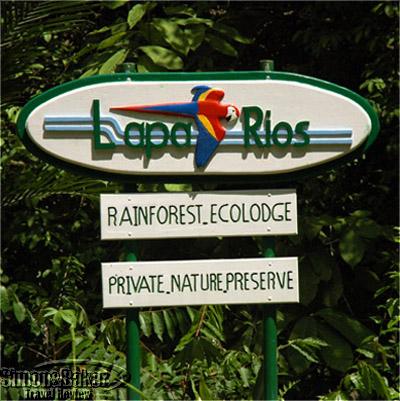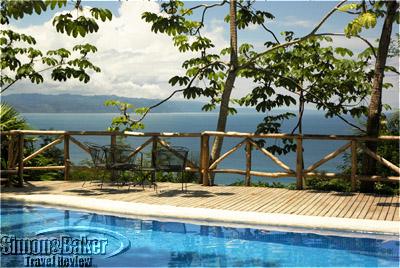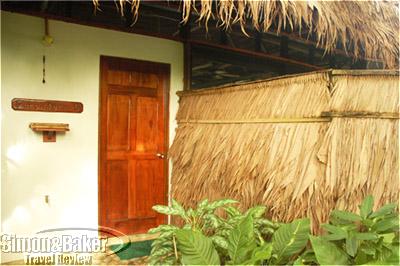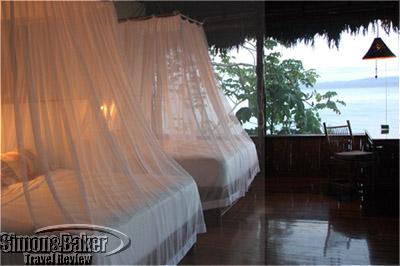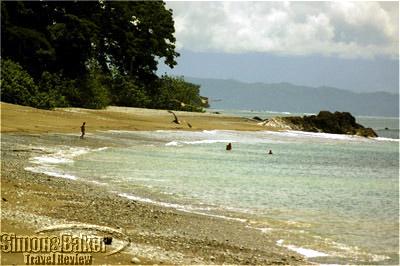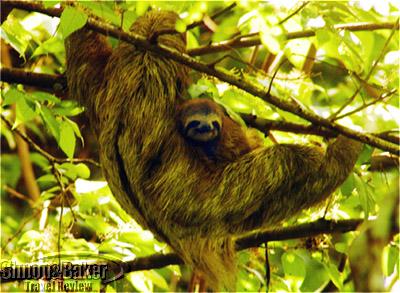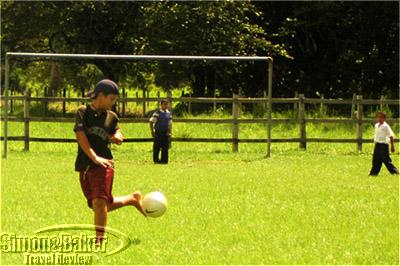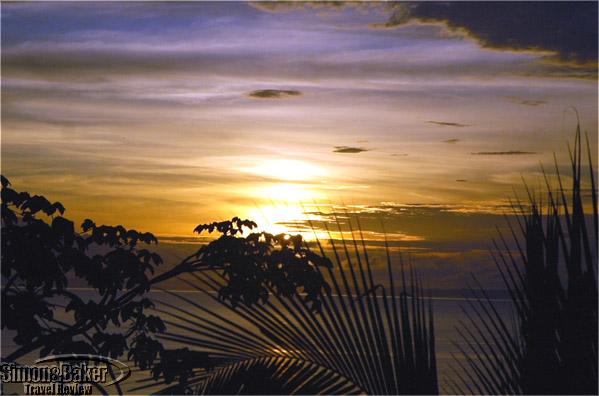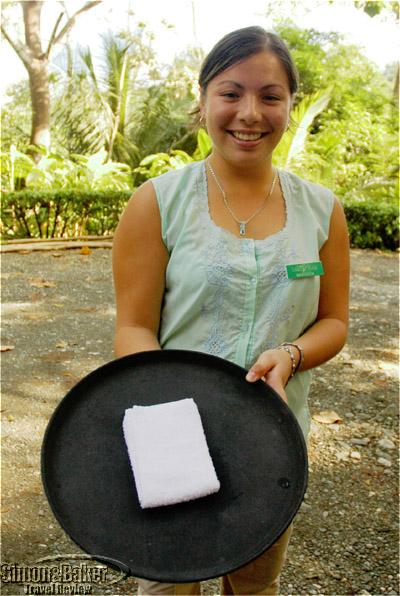

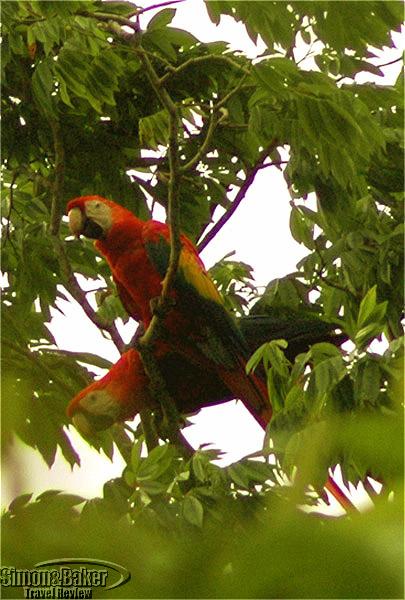
My Lapa Rios experience was further enhanced by the obvious dedication of the staff to ensuring that I enjoyed every moment of my visit. The instant my small commuter plane landed in Puerto Jimenez, I was welcomed by friendly staff members. They immediately retrieved my luggage and whisked me off to an awaiting open four-wheel drive truck with padded benches and a stand up roof held up by sturdy roll bars, for the forty-five minute drive on the rocky dirt road to the resort. Before the truck even came to a stop under the lodge’s thatched awning, two staff members materialized with a welcoming chilled towel to wipe away the dust of the trip, and a tall glass of a tropical fruit juice blend that tasted like pure ambrosia. This same thoughtful attention to my comfort was unfailing throughout my visit.
But Lapa Rios was more than a haven of understated luxury and flawless service in an idyllic setting. It was also the heart of a major nature preservation and community development program that has become an international model of the responsible use of ecotourism. It was intensely satisfying for me to know that by staying at Lapa Rios, I was not only contributing to the preservation of one of the most biodiverse primary forest environments on the planet, but also to providing stable income and growth opportunities for the families of the 57 employees of the resort.
General Management Lapa Rios has been managed since 1999 by Cayuga Sustainable Hospitality, a leading organization in the management and development of luxury ecotourism facilities in Latin America.
Handicapped Access No
Length Of Stay Three nights
Location Lapa Rios was located at the southern-most point the Osa Peninsula, where the Golfo Dulce meets the Pacific Ocean, 250 miles southwest of San Jose, Costa Rica’s capital city and main international airport. The small town and landing strip of Puerto Jimenez were approximately 12 miles away from the resort.
On-Site Manager Jorge Arrieta
Owners John and Karen Lewis, two former Peace Corps volunteers from Minneapolis, Minnesota were the owners. They abandoned their professional careers (John was a lawyer and Karen a music teacher) in 1990 to dedicate all their resources and efforts to permanently protect from logging, poaching and uncontrolled development more than 1,000 acres of mainly primary forest with a unique biodiversity value. The Lapa Rios Ecolodge was built in 1993 to support the maintenance of the private reserve and provide sustainable economic development to the local community.
Size The ecolodge sat on a five-acre site tucked away within the 1,000-acre private nature preserve. Its 16 guest bungalows were scattered down a 500-yard path from the main lodge. The facility employed a full time staff of 57, all Costa Rican nationals, 52 of them from the local community.
Transportation From international destinations, Juan Santamaria International Airport in San Jose was the most common point of entry into the country. From there, two local airlines, NatureAir and Santa, offer convenient daily scheduled flights to Puerto Jimenez. My transfer to the resort was pre-arranged with Lapa Rios at the time of reservation. It was also possible to drive from San Jose. However, due to the difficult terrain and precarious road conditions, the trip usually takes between eight to ten hours. Once at Lapa Rios, transportation was available through the resort for any excursion beyond walking distance.
Year Open-Renovated Lapa Rios originally opened with 6 bungalows in 1993, and was gradually expended to its actual capacity of 16 bungalows. The latest major renovation occurred in 2004.
Room My bungalow, number 6, was a leisurely five-minute walk from the main lodge. The airy 460-square-foot bedroom and bathroom suite was isolated from the path by stucco’ed walls. The internal walls, open on three sides onto the private deck and the forest, were screened to let in the cooling breezes and sweeping views. The two queen-sized beds were swathed in mosquito netting and separated by a bedside table. Furnishings included a writing desk and chair, and a seating area with two armchairs padded with brightly striped cushions and a corner end table, all made of local bamboo. Storage shelving completed the décor. The floor was of dark, highly polished cristobal wood. There was ample indirect lighting around the room, and two overhead fans to ensure comfortable air circulation, although the latter were not necessary during my stay. The private deck and patio included an outdoor shower, three lounge chairs, a rocking chair and a large white cotton hammock.
Beach It was a fifteen minute steep walk down to the gulf. The sandy public beach was deserted and offered no facilities or amenities, but it was pleasant for walking or bathing in the surf, or watching pelicans dive for their lunch.
Facilities The swimming pool was located just down the path from the main lodge. The “Tours Hut” was nearby; it was the departure point for all tours and hikes. A yoga deck and massage room were in their own hut, another minute’s walk down the hill, discretely concealed in the dense foliage.
Pool The large, approximately 40 by 25 foot pool varied in depth from three to seven feet. It was an inviting place to swim, and it offered such a spectacular view of the Golfo Dulce that I was sometimes content to soak in it while admiring the panorama below. The pool was chlorine free, using only natural salts to keep it clean. Over a dozen metal lounge chairs circled the pool, several of them in a shaded area under a large thatched roof. Ample supplies of towels were stored in a bamboo cabinet.
Wildlife Viewing The area was teaming with wildlife. A simple stroll from my bungalow to the main lodge could mean an encounter with a three-toed sloth languidly stretching through the branches of a nearby cecropia tree, her baby clinging to her flank; or a large coati mundi unhurriedly crossing the path ahead. Birds were ever present. On an easy two-hour guided walk, I was able to sight over two dozen varieties.
The Sustainability Tour, a behind-the-scenes visit of the property, gave me a detailed insight of, and renewed appreciation for the uncompromising efforts that have earned Lapa Rios the prestigious “Five Leaves Sustainability Certification Award” (the highest recognition awarded by the Costa Rican Ministry of Tourism). This fascinating visit covered everything from bio-degradable building materials to laundry practices, and sorting of all kitchen leftovers (from the lodge and staff kitchens) to be either composted or sent to the pigpen. Approximately a dozen pigs were raised with these leftovers. The excrements produced by the pigs were hosed down into a hermetic tank where bacteria developed to produce methane gas, which was then piped to the staff kitchen where it fueled the gas stove used to prepare the 2,200 meals per month consumed by the employees. This process was implemented at the recommendation of one of the local employees, who had observed it in his village.
Both tours were free of charge and could be scheduled at the reception desk.
Therapeutic massage and Hatha Yoga lessons were available by appointment.
Recognition And Awards In addition to its Five Leaves Sustainability Certification from the Costa Rican Ministry of Tourism, received in 2003, Lapa Rios was a 2005 recipient of the U.S. State Department Corporate Excellence Award, a recognition awarded to U.S. companies operating overseas for their “exemplary employment practices, responsible environmental stewardship and practices, and contribution to the overall growth and development of the local economy.” Lapa Rios was also recognized as one of the five best ecolodges in the world by Conde Nast (Green Award 2005), and voted one of the ten best hotels and resorts in Mexico and Latin America by Conde Nast readers (Readers Choice Award 2005).
Date Of Review May 2006
ReviewersArticle and photographs by Josette King
Service Excellent. All guest-facing functions were handled by a team of local young men and women who were unfailingly prompt, cheerful and attentive to my comfort and requests. They understood and spoke English with varying proficiency, but all were visibly eager to learn.
Would You Stay There Again? Yes
Contact Information
- Playa Carbonera
- Osa Peninsula, Costa Rica
- USA Mail Drop
- PO Box 0252160 – SJO 706
- Miami, FL 33102-5216
- + 506 735-5130
- or + 506 735-5281
- + 506 735-5179
